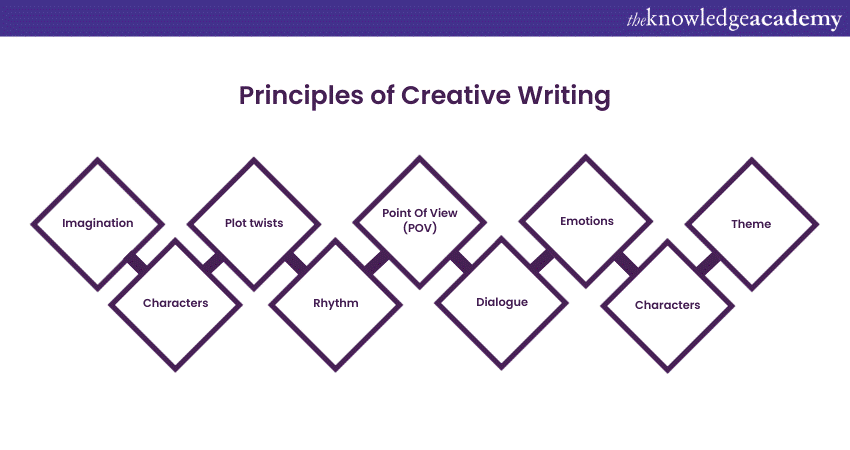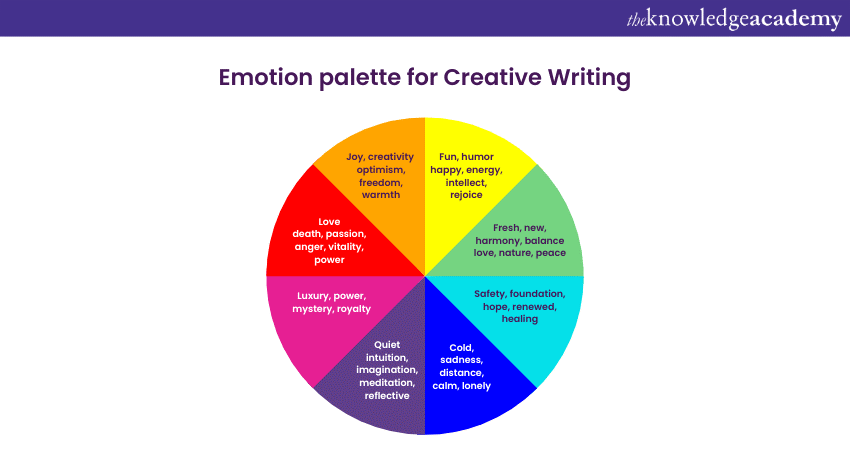We may not have the course you’re looking for. If you enquire or give us a call on +44 1344 203999 and speak to our training experts, we may still be able to help with your training requirements.
Training Outcomes Within Your Budget!
We ensure quality, budget-alignment, and timely delivery by our expert instructors.

Creative Writing is an art that allows individuals to express their thoughts, emotions, and stories in imaginative and compelling ways. If you're an aspiring Writer or an experienced Creative Writer looking to advance your skills, understanding the Principles of Creative Writing is essential. Creative Writing principles are basic concepts and guidelines Writers use to enhance the quality and impact of their written work. Further, in this blog, we will explore the core Principles of Creative Writing that form the foundation of exceptional writing.
Table of Contents
1) Understanding Creative Writing Principles
2) Principles of Creative Writing
a) Imagination knows no bounds
b) Crafting compelling characters
c) Plot twists and turns
d) Setting the stage
e) Point of View (POV) and voice
f) Dialogue - The voice of your characters
g) Conflict and tension
h) Show, don't tell
i) Editing and revising with precision
j) The power of theme and symbolism
k) Pacing and rhythm
l) Emotionally resonant writing
m) Atmosphere and mood
3) Conclusion
Understanding Creative Writing Principles
Before we move on to the Principles for Creative Writers, let’s first understand the concept of Creative Writing. Creative Writing is an exploration of human expression, a channel through which Writers communicate their unique perspectives, experiences, and stories.
This form of writing encompasses various genres, such as fiction, poetry, drama, and more. Unlike Technical or Academic Writing, Creative Writing is driven by the desire to evoke emotions, engage readers, and transport them to alternate worlds.
Take your academic writing to the next level – join our Academic Writing Masterclass and unlock the art of effective writing and communication!
Principles of Creative Writing
Now that you know the meaning of Creative Writing, let’s explore its principles.

Principle 1: Imagination knows no bounds
Your imagination is a treasure trove of ideas waiting to be explored. To cultivate your creative imagination:
a) Allow yourself to think without limitations.
b) Let thoughts collide and see where they lead.
c) Keep a journal to jot down fleeting ideas and use them as springboards for your writing.
Break free from conventional thought patterns—experiment with "what if" scenarios – twist familiar elements into something new. Blend genres, combine unrelated concepts, or put your characters in unexpected situations.
Principle 2: Crafting compelling characters
Characters are the heart of your story. Develop characters with distinct personalities, motivations, strengths, and flaws. Delve into their backgrounds, understanding their past experiences and how they shape their choices. Consider their beliefs, fears, desires, and relationships with others in the story.
Readers connect with characters they can relate to. Make your characters multifaceted by giving them relatable qualities. Flaws make characters human, so don't hesitate to bestow imperfections upon them. Your readers will find themselves emotionally invested in their journeys as they face challenges and grow.
Principle 3: Plot twists and turns
A well-crafted story thrives on plot twists and turns. These unexpected shifts keep readers engaged, encouraging them to explore the unknown alongside your characters. The art of plot twists lies in weaving surprises that challenge characters' assumptions and drive the story in unexpected directions.
Develop logical and unforeseen twists, leaving your audience eager to discover what happens next. Experiment with various narrative structures. Choose the structure that best serves your story's theme and tone.
Principle 4: Setting the stage
Transport readers into your story's world by vividly describing its physical elements – sights, sounds, smells, and textures. The setting isn't merely a backdrop; it's a living, breathing entity that influences the mood and atmosphere of your narrative. Create an immersive experience that makes readers feel like they're living the story alongside your characters. Make the setting integral to your storytelling, whether a bustling urban landscape or serene countryside.
Principle 5: Point of View (POV) and voice
Point of View (POV) and voice are essential tools that shape how your story is perceived. POV determines the perspective through which readers experience the narrative – whether through a character's eyes (first person), an external observer (third person limited), or an all-knowing narrator (third person omniscient). Each POV offers a distinct vantage point, influencing what readers know and how they connect with the characters.
On the other hand, voice is the unique style and tone of your writing that reflects the narrator's personality and worldview. Skilful manipulation of POV and voice deepens readers' immersion and connection with the story.
Principle 6: Dialogue - The voice of your characters
Dialogue is a powerful tool for revealing character relationships and advancing the plot. It's the medium through which characters reveal their personalities, motivations, and conflicts. Make your dialogue sound natural by paying attention to speech patterns, interruptions, and nuances.
Each character should possess a distinctive voice, reflecting their background, emotions, and quirks. Effective dialogue moves the plot forward, adds depth to relationships, and provides insight into characters' inner worlds.
Master your copywriting skills today with our Copywriting Masterclass and create compelling content that drives conversions. Join now!
Principle 7: Conflict and tension
Conflict drives your story forward. Whether internal (within a character's mind) or external (between characters or forces), conflicts create stakes and keep readers invested. Make conflicts meaningful by connecting them to your characters' goals and desires. Tension, on the other hand, keeps readers engaged by evoking curiosity and emotional investment.
Principle 8: Show, don't tell
"Show, don't tell" is a principle that encourages subtlety and reader engagement. Instead of directly stating emotions or information, show them through actions, behaviours, and sensory details. Allow readers to draw their own conclusions, fostering a deeper connection to the narrative.
For example, instead of stating, "She was sad," show her wiping away a tear and gazing out the rain-soaked window. This approach not only immerses readers in the story but also invites them to interpret and empathise with the characters' experiences.
Principle 9: Editing and revising with precision
Your first draft is just the beginning. Editing and revising refine your work into its best version. Editing is not just about correcting grammar; it's about refining your prose to convey your message with clarity and impact. Read your work critically, checking for consistency in tone, pacing, and character development. Trim unnecessary elements and tighten sentences to eliminate any ambiguity. Embrace the art of revision to sculpt your rough draft into a polished masterpiece.
Principle 10: The power of theme and symbolism
Themes and symbolism add meaning to your writing, inviting readers to explore more profound insights. A theme is your story's central idea or message, while symbolism uses objects, actions, or concepts to represent abstract ideas. By infusing your narrative with meaningful themes and symbolism, you create a tapestry of thought-provoking connections that engage readers on both intellectual and emotional levels.
Principle 11: Pacing and rhythm
The rhythm of your writing affects how readers engage with your story. Experiment with sentence lengths and structures to create a natural flow that guides readers seamlessly through the narrative. Vary pacing to match the intensity of the scenes; fast-paced action should have short, punchy sentences, while contemplative moments can benefit from longer, more introspective prose. Mastering rhythm and flow keep readers entranced from start to finish.
Principle 12: Emotionally resonant writing

The goal of Creative Writing is to evoke emotions in your readers. Develop empathy for your characters and encourage readers to feel alongside them. Tap into your own experiences and emotions to connect with readers on a human level. Emotionally charged writing doesn't just entertain; it leaves a mark on readers' hearts, reminding them of shared experiences and universal truths.
Principle 13: Atmosphere and mood
The atmosphere and mood of a story set the tone for readers' experiences. Through careful selection of words, sentence structures, and descriptive details, you can shape the emotional ambience of your narrative. Whether you're writing an exciting thriller, a magical fantasy, or a serious drama, infuse your writing with an atmosphere that wraps readers in the emotions you want them to feel.
Conclusion
The Principles of Creative Writing provide a roadmap for crafting stories that captivate and inspire. These principles allow you to transform your writing from ordinary to extraordinary easily. As you work on becoming a Creative Writer, remember that practice is key. Each principle mentioned here is like a tool in your Writer's toolbox, waiting to be improved and used effectively.
Elevate your writing skills with our Creative Writing Training. Join today to unleash your creativity!
Frequently Asked Questions
Upcoming Business Skills Resources Batches & Dates
Date
 Creative Writing Course
Creative Writing Course
Fri 10th Jan 2025
Fri 28th Feb 2025
Fri 4th Apr 2025
Fri 16th May 2025
Fri 11th Jul 2025
Fri 19th Sep 2025
Fri 21st Nov 2025







 Top Rated Course
Top Rated Course



 If you wish to make any changes to your course, please
If you wish to make any changes to your course, please


